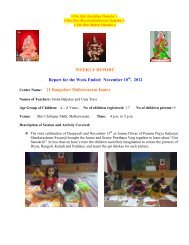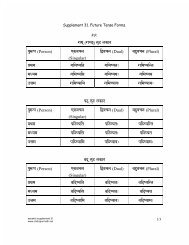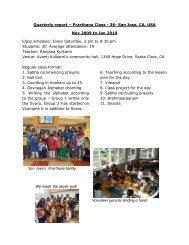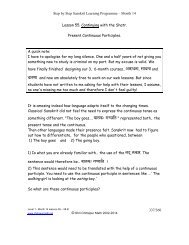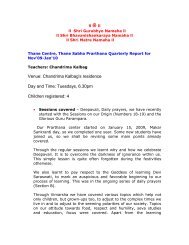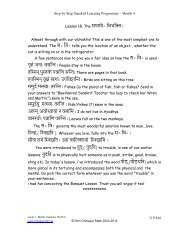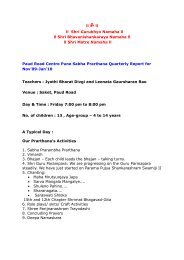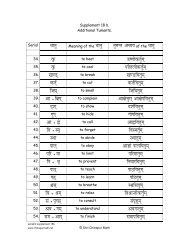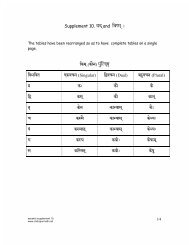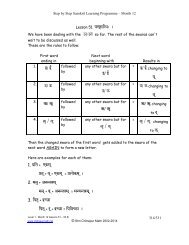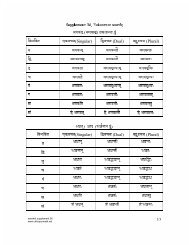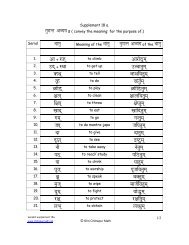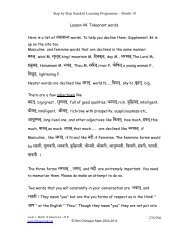prarthana report â 21 malleswaram junior - Shri Chitrapur Math
prarthana report â 21 malleswaram junior - Shri Chitrapur Math
prarthana report â 21 malleswaram junior - Shri Chitrapur Math
You also want an ePaper? Increase the reach of your titles
YUMPU automatically turns print PDFs into web optimized ePapers that Google loves.
।। ॐ श गरभ नम ।।।। ॐ श भवनशकर नम ।।।। ॐ श मत नम ।।PRARTHANA REPORT – <strong>21</strong> MALLESWARAM JUNIORTeachers: Smita Baljekar, Bhavani Nayel, Gayatri Trasi, Uma Savur, Uma TrasiNo of children: 25Age Group: 4 – 8 years.Venue: <strong>Shri</strong> <strong>Chitrapur</strong> <strong>Math</strong> Bangalore Time: Saturday 4-5 p.m.Junior Prarthana classes which had commenced in Malleswaram, Bangalore inSeptember 2008, soon turned a YEAR OLD!! The children now flawlessly recite the“Sabha Commencing prayers”, “Sabha Concluding Prayers” and other stotras andshlokas!!Vimarsha sessions have continued on different topics. Ideas on Divinity and God wereintroduced through stories of Prahlada and Markandeya. The children expressed thatif we call on God, He will always come to our help if our prayer is sincere. God takescare of his devotees and there is nothing to fear if one has faith and is devoted toHim. The stories and Vimarsha have created lot of interest. Advaith wanted to know“if Markandeya is Chiranjeevi why are we not able to see him now?”The session on “Humility” or Namrata was explained through the stories of “Arjuna,the Monkey and the Boy” and the story of Duryodhana and Arjuna seeking LordKrishna’s help before commencement of war. One popular example cited by childrenwas “When children receive gifts from Grandparents/parents, they show humility bydoing namaskar or by saying Thank you”. This was followed by an activity on“Humility Tree” which had several branches, with each branch representing aparticular quality e.g. “I never make mistakes”, “I thank God for my achievements.”The children had to classify and say aloud whether the fruits from the Humility treewould be a “Red fruit” – a good quality indicating “humility” or a “Yellowfruit” – a bad quality indicating “ego”. It was sheer joy to watch theirspontaneity, and the different thoughts which poured out as examples of Red fruit orYellow fruit. Several cute examples of Red and Yellow fruits followed – Thank god for
everything (Aditya), Be humble and give respect (Shivani), Saying “She is verybad” (Akshay), Hit and hurt others (Advait), Never be rude (Prakruti), Pray toGod everyday (Nishtha), Don’t be good (Pranav), Always obey your teachers andparents (Nidhi & Divyangi), Be gentle (Shraddha), Study everyday (Viha), Stealother’s things (Aditi), No fighting in class (Pranav) and so on.The importance of Atithi Devo Bhava was explained with the story of The GoldenMongoose. In “Attitude towards food” the children were told how home cooked food isclean, cooked with love and is nutritious. The journey of food from the fields to thedining table was discussed, and how as many as 22 people are involved in thisprocess. So one should respect food and not waste it, and at no time should one getangry while eating food. Tanya said with a twinkle in her eyes that a quiz competitionin school had Pasta Treat as the prize from the Company. Most children agreed thatone should not waste food and said that they eat all the vegetables cooked at home.We moved on to the next topic -“Focus/concentration” supported by stories and anactivity. The story of two frogs & the pot of curds was narrated, with activeparticipation from some students who knew this story. It brought forth interestingpoints from the children namely- Try and try until you succeed, never give up, remainfocused and not look around! The stories of Arjuna (the wooden bird & fish’s eye)were narrated as examples. The importance of concentrationand focus in order to achieve a goal was emphasized. Anexample in the context of studies was also explained. Theactivity game of “spot the difference” was conducted, to testtheir ability to focus. Each child was handed a sheet with twopictures that seem identical but actually have 15 differences.We discussed on another vimarsha topic “Swadhyay" and Ekalavya’s story wasnarrated. Stotras “Samudra Vasane Devi” was taught with meaning and “Saraswatinamastubhyam” was revised.The much awaited Quiz session was conducted in the 1 st two weeks of Jan 2010covering Sabha Prarambha Prarthana and the related stories. While on the topic ofDhyana posture, five-year old Amogh said we see God when we close our eyes.Four-year old Pranav replied that we see God through our mind, when we close oureyes. Others expressed that they felt peaceful when they sat in this posture. Thechildren recalled all the bhajans they had learnt during their Prarthana Vargas andeagerly sang a few bhajans and did not want to stop.On 16 th Jan 2010, we were blessed with Divya Darshan of Parama Pujya Swamiji whohad just arrived from Chennai and was to leave for Shirali next morning. All thechildren, teachers and parents were overjoyed. Pujya Swamiji asked the children whythey were all there. In unison they said “Prarthana class". Pujya Swamiji asked themthe duration of the class and very sweetly said “He would be upstairs and not disturbthem”. What a beautiful lesson to learn!Activities:
Festivals are generally celebrated with a special activity. For Navaratri, children weretold that the Devi takes nine different Forms. The different names of the Deviassociated with each day (Prathamam – Shailaputri, Dwitiyam – Brahmacharini,……,Navamam – Siddhidatri) was introduced and was recited thrice.“Dandiya making” activity was taken up using news-paper rolls.Children spent some time on stage dancing with the decoratedpaper dandiyas. Few of them even drew pictures of Devi. Thesignificance of Kojagiri/Narali Poornima was explained to thechildren. Little Pranav said that on Kojagiri Poornima, Devi peepsthrough the window and blesses children who are awake and good.Card making session was taken up for the “Festival of lights” byGowri from Prerana Varga.14 November- Kartikmase Krishnapakshe TrayodashyamThe class began with prayers followed by recitation of two verses from the <strong>Shri</strong>Parijnanashram Trayodashi. Later the children were grouped together to performGuru Pujan with the Panchopchara Puja. Before the Pujan, the children were told thesignificance of Paduka Pujan. They were briefed on the five Upchaars offered –Gandha akshath, Pushpa, Dhoopa, Deepa and Naivedya. There was a lot ofexcitement and the children wholeheartedly participated in the Pujan.Children doing Panchopachara Puja on 14 NovemberDry fruits and Doodhpedhas were offered as naivedya. The Shloka AnnapoorneSadapoorne was recited before partaking of Prasad. After the Pujan, the childrenparticipated in a 1-minute “memory” game (photograph shown alongside). They weregiven 1 minute to observe the objects arranged on the table, then had to write downfrom memory as many objects a they could remember.
On the Gita Jayanthi - 28 th Nov, the significance of the daywas discussed, followed by a quiz. The quiz included theimportance of Gita Jayanthi, the number of chapters and verses in the Bhagavad-Gita, who was given Upadesha etc. They were asked to see the Gitopadesha picturein the <strong>Math</strong> and speak about it. The children who had participated in this year’sBhagavad-Gita competition were cheered. The other children promised to participatenext year. Together we sang the Dhyana shlokas of the Bhagavad-Gita.Children offered seva on 9 th Dec evening at our <strong>Math</strong> for the Punyatithi ofParama Pujya Krishnashrama Swamiji. Verses from the Shishya Sweekarpages of Anugraha book, Bhavanishankar Suprabhatam,Deepanamaskar, and Shankar Narayan Geet were rendered.For Sankranti festival, the children had a paper box activity to serve“Til Gul”. This activity was demonstrated by Deepali from the PreranaVarga.January saw rehearsals for the children’s programme <strong>Shri</strong> Guru Vandana which wasto be presented for Trayodashamanotsav on 3 rd Feb 2010. After the rehearsals, ashort Swadhyaya on the names and incidents that appeared in the <strong>Shri</strong> GuruVandana was conducted, using photographs appearing in previous issues of Sunbeamand Kanara Saraswat, and the Vantiga Directory. All the children showed a keeninterest to see the pictures and learn about the incidents.Guru showers His AnugrahaOn January 31 st the children had settled to write a few sentences on “What Prarthanameans to me” or “I like Prarthana because—” and Pujya Swamiji blessed the classwith His Divine presence. It was truly दव आम बळ आमच समभळ .Children have benefited enormously from the classes, and we invite more children tobe part of Prarthana. We teachers are blessed that we have been given anopportunity to participate in Guru Karya and we cherish it immensely.……. Namah Parvati Pataye Hara Hara Mahadeva …….- o O o -



